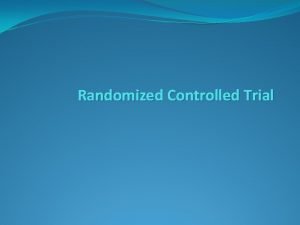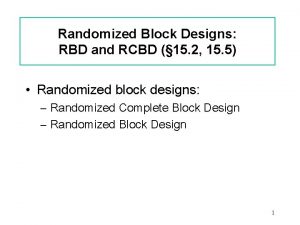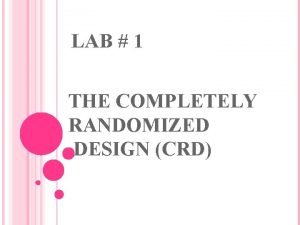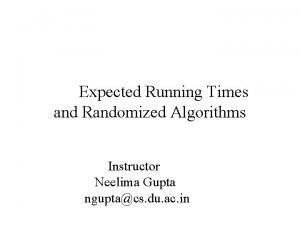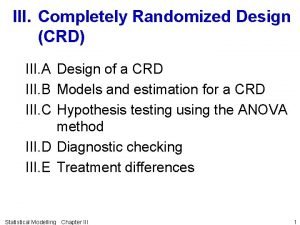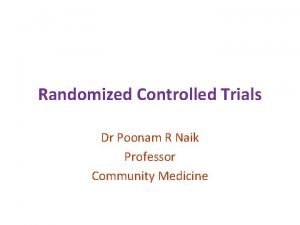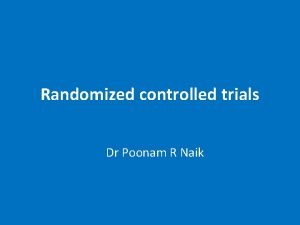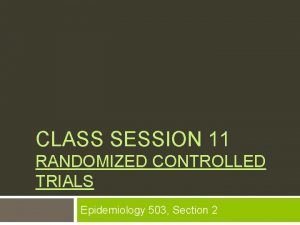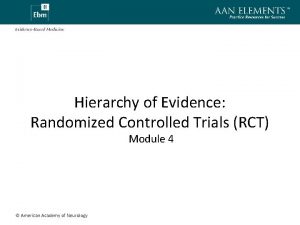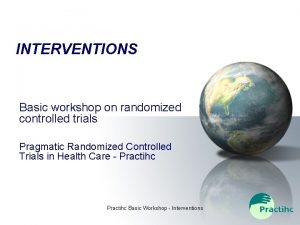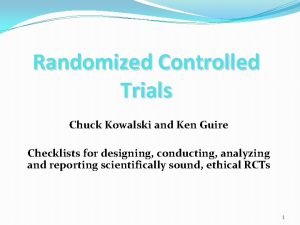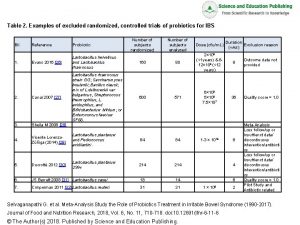Randomized Controlled Trials in a selfimproving health PROFESSOR


























- Slides: 26

Randomized Controlled Trial’s in a self-improving health PROFESSOR JOHN ZALCBERG system Chair, ACTA 1 March 2019 30/30 Horizons in Health Care

Self-improving Health System Fundamental principles 1. High quality health care is critical to patients and saves money. 2. High quality care (value-based health care) is evidence-based 3. Best evidence is derived from randomized clinical trials (RCTs)

Idealized model of a self-improving health system

The role of quality registries – detection of unwarranted variation

Why is there unwarranted variation? • Differences in supply and accessibility of services • Evidence doesn’t exist, or clinicians don’t know about it • Evidence is not accepted weak evidence, clinicians can’t see how it applies to their practice or ? ? • Personal preferences of clinicians • Other incentives (e. g. financial) for certain practices to continue/start/stop

Why is there unwarranted variation? • Differences in supply and accessibility of services • Evidence doesn’t exist, or clinicians don’t know about it evidence overload? • Evidence is not accepted weak evidence, clinicians can’t see how it applies to their practice or ? ? • Personal preferences of clinicians • Other incentives (e. g. financial) for certain practices to continue/start/stop

C u. Current Australian Colorectal Cancer Guidelines r Grade of Description Levels of Evidence r Recommendation e A Body of evidence can be trusted to guide practice 1 n t B Body of evidence can be trusted to guide practice in 1 C o l o r e most situations C Body of evidence provides some support for recommendation(s) but care should be taken in its application 16 D Body of evidence is weak and recommendation must be applied with caution 17 Consensus 16

The role of RCTs is to test interventions to prove or disprove an hypothesis

Clinical Trials vs Registries; both contribute to the self-improving health system Clinical trial Registry Investigational – hypothesis testing Observational Measures the efficacy of a treatment in a carefully selected patient cohort Measures effectiveness of treatment in the population captured by the registry Resourced for data collection Often not resourced for data collection Finite data collection period Indefinite data collection period Collect large amount of data Collect minimal amount of data Level II evidence Level III evidence

Clinical Quality Registries vs Clinical Trials Attributes Clinical trial Registry Coverage Usually small and unrepresentative of general population Whole population Purpose Identifying what care should be delivered Measuring whether good care is being delivered and impact on health outcomes (quality of life, survival, recurrence, cost)

Improving Registries Embedding clinical trials WITHIN registries – trials in real world populations

Do RCTs lead to improved outcomes in the population at large? 1. Within trial population receiving new therapy 2. Within control groups within randomized trials 3. Within centres that are research active?

Randomized Clinical trials lead to improved outcomes 1. Within trial population receiving new therapy 2. Within control groups within randomized trials 3. Within centres that are research active?

The research engagement/outcome relationship

NIHR CCRN funding (£/bed) Mortality between highest and lowest Trusts = 1. 05 [1. 0331. 068] p<0. 0001

The research engagement/outcome relationship Total inpatient pool – 174, 062 Total trial accrual – 4, 590 (3%) in 494 hospitals

Adherence to evidence-based guideline recommendations p<0. 008 76. 9% 78. 3% 81. 1% At 494 CRUSADE (Can Rapid Risk Stratification of Unstable Angina Patients Suppress Adverse Outcomes With Early Implementation of the American College of Cardiology/American Heart Association Guidelines) hospitals.

Short-term mortality In 174, 062 patients with acute coronary syndrome treated at 494 CRUSADE hospitals.

How do we facilitate implementation of results of

How do we facilitate implementation of results of RCTs? USA TRIAL Answer – by doing more RCTs… DEFINE TRIAL 2018 ANALYSED 2020 ABSTRACT 2022 PUBLISHED 2024 RADAR 2026 EVIDENCE GUIDELINES AUSTRALIAN PRACTICE AUSTRALIAN TRIAL DEFINE TRIAL 2018 DEFINE ANALYSED 2020 TRIAL 2022 RESULTS AUSTRALIAN PRACTICE ABSTRACT 2024 CHANGE 2028 PUBLISHED 2026 2030 CHANGE


Topgear trial R a n d o mi se Chemo Sx ECC x 3 Chemo ECC x 2 ECC x 3 Chemo/XRT = radiation therapy Sx = surgery Sx ECC x 3

Why must we embed clinicians in this process? �Question quality of care �Test the existing evidence-base �Implement results of trials in which they are embedded �Lead to more rapid adoption �Train workforce �Provide career opportunities attracting the best to question the status quo. Research in health care = How do we do Health Better?

Clinicians or Networks (CTNs) of Clinicians? �Access to sufficient sample size – thousands of patients �One-time infrastructure creation �Growing research culture �Extensive and growing corporate knowledge �Clinician-led, clinician relevant and mentoring next generation �Effectively collaborate with similar international networks �Bedside-to-beside translation of research into practice

Conclusion RCTs are central to a self-improving (value-based ) health system.

Acknowledgements • Patients • Board of ACTA • Sue Evans/Tony Keech/John Mc. Neil/John Simes/Steve Webb
 Advantage of randomized controlled trial
Advantage of randomized controlled trial Promotion from assistant to associate professor
Promotion from assistant to associate professor Randomized polynomial time
Randomized polynomial time Completely randomized design
Completely randomized design Randomized skip list
Randomized skip list Randomized group design
Randomized group design Randomized block design
Randomized block design Crd rcbd
Crd rcbd Randomised block design
Randomised block design Types of randomized algorithms
Types of randomized algorithms Rcbd meaning in research
Rcbd meaning in research Completely randomized design (crd)
Completely randomized design (crd) Randomized hill climbing
Randomized hill climbing Randomized block design vs matched pairs
Randomized block design vs matched pairs Expected running time
Expected running time Completely randomized design
Completely randomized design Randomized hill climbing
Randomized hill climbing Contoh rancangan acak kelompok
Contoh rancangan acak kelompok Statistical model for crd
Statistical model for crd Factorial randomized block design
Factorial randomized block design Probabilistic analysis and randomized algorithms
Probabilistic analysis and randomized algorithms Randomized polynomial time
Randomized polynomial time Openlabeling
Openlabeling Randomized algorithm in daa
Randomized algorithm in daa Randomized block design example
Randomized block design example Salem witch trials discovery education
Salem witch trials discovery education National geographic salem witch trials
National geographic salem witch trials
